Effect of In and Pr on the Microstructure and Properties of Low-Silver Filler Metal
Abstract
:1. Introduction
2. Materials and Methods
3. Results
3.1. Melting Temperature of the Novel Low-Silver Filler Metals
3.2. Wettability of the Novel Low-Silver Filler Metals
3.3. Microstructure of the Novel Low-Silver Filler Metals
3.4. Microstructure of the Brazing Joints
3.5. Mechanical Properties of Brazed Joints
4. Conclusions
- (1)
- The decreases in both Ts and Tl are attributed to the addition of In; trace amounts of Pr have little impact on the melting temperature of the low-silver filler metals.
- (2)
- The spreading area of the filler metals on copper and 304 stainless steel substrate reaches the peak when the contents of In and Pr are 2 wt.% and 0.15 wt.%, respectively. Excessive Pr elements will inhibit the wettability of the filler metals.
- (3)
- The microstructure of the filler metal and brazing joints produces a significant refinement when the Pr content is 0.15 wt.%. However, Cu4In, Ag9In4 and bright Pr3Cu4Sn4 phase were formed in the 12AgCuZnSn-5In-0.5Pr brazing alloy.
- (4)
- The peak shear strength of steel/steel brazing joint is obtained using 12AgCuZnSn-2In-0.15Pr filler metal, and the corresponding fracture morphology exhibits typical ductile characteristic with obvious dimples. However, some globular Pr-rich particles are found in the fracture morphology when the content of Pr reaches 0.5 wt.%.
Author Contributions
Funding
Acknowledgments
Conflicts of Interest
References
- Fukikoshi, T.; Watanabe, Y.; Miyazawa, Y.; Kanasaki, F. Brazing of copper to stainless steel with a low-silver-content brazing filler metal. IOP Conf. Ser. Mater. Sci. Eng. 2014, 61, 1–6. [Google Scholar] [CrossRef]
- Wang, X.X.; Peng, J.; Cui, D.T.; Xue, P.; Li, H.; Hu, A.M.; Sun, G.Y. Research and application of silver-based brazing alloys in manufacturing industries. Mater. Rev. 2018, 32, 1477–1485. [Google Scholar]
- Amelzadeh, M.; Mirsalehi, S.E. Dissimilar joining of WC-Co to steel by low-temperature brazing. Mater. Sci. Eng. 2020, 259, 1–9. [Google Scholar] [CrossRef]
- Mousavi, S.A.; Sherafati, P.; Hoseinion, M.M. Investigation on wettability and metallurgical and mechanical properties of cemented carbide and steel brazed joint. Adv. Mater. Res. 2012, 445, 759–764. [Google Scholar] [CrossRef]
- Ongondo, F.O.; Williams, I.D.; Cherrett, T.J. How are WEEE doing? A global review of the management of electrical and electronic wastes. Waste Manag. 2011, 31, 714–730. [Google Scholar] [CrossRef]
- Xue, P.; Zou, Y.; He, P.; Pei, Y.Y.; Sun, H.W.; Ma, C.L.; Luo, J.Y. Development of low silver AgCuZnSn filler metal for Cu/steel dissimilar metal joining. Metals 2019, 9, 198. [Google Scholar] [CrossRef] [Green Version]
- Shapiro, A.E.; Shapiro, L.A. New low-silver filler metal for brazing cemented carbides. Weld. J. 2015, 94, 70–71. [Google Scholar]
- Long, W.M.; Zhang, G.X.; Zhang, Q.K. In situ synthesis of high strength Ag brazing filler metals during induction brazing process. Scr. Mater. 2016, 110, 41–43. [Google Scholar] [CrossRef]
- Long, W.M.; Liu, D.S.; Dong, X.; Wu, A.P. Laser power effects on properties of laser brazing diamond coating. Surf. Eng. 2020, 36, 1315–1326. [Google Scholar] [CrossRef]
- Long, W.M.; Li, S.N.; Shen, Y.X.; Du, D.; Zhong, S.J.; Wang, Q.; Zhang, L. Overview of the brazing of carbon-carbon composites. Rare Met. Mater. Eng. 2020, 49, 2683–2690. [Google Scholar]
- Karpiński, M. Microstructure of a joint of sintered carbides and steel brazed with Ag-Cu-Zn-Mn-Ni filler metal. Mater. Tehnol. 2020, 54, 485–488. [Google Scholar] [CrossRef]
- Li, M.G.; Sun, D.Q.; Qiu, X.M.; Yin, S.Q. Effect of tin on melting temperature and microstructure of Ag–Cu–Zn–Sn filler metals. Met. Sci. J. 2013, 21, 1318–1322. [Google Scholar] [CrossRef]
- Jintakosol, T.; Nitayaphat, W. Influence of tin addition on the microstructure, melt properties and mechanical properties of Ag-Cu-Zn-Sn braze filler. Int. J. Mater. Mech. Manuf. 2018, 6, 291–294. [Google Scholar] [CrossRef] [Green Version]
- Ma, C.L.; Xue, S.B.; Zhang, T.; Jiang, J.Y.; Zhang, G.X.; Zhang, Q.K.; He, P. Influences of In on the microstructure and mechanical properties of low silver Ag-Cu-Zn filler metal. Rare Met. Mater. Eng. 2017, 46, 2565–2570. [Google Scholar]
- Ma, C.L.; Xue, S.B.; Wang, B.; Wang, J.X.; Hu, A.M. Effect of Ce addition on the microstructure and properties of Ag17CuZnSn filler metal. J. Mater. Eng. Perform. 2017, 26, 3180–3190. [Google Scholar] [CrossRef]
- Ma, C.L.; Xue, S.B.; Wang, B. Study on novel Ag-Cu-Zn-Sn brazing filler metal bearing Ga. J. Alloys Compd. 2016, 688, 854–862. [Google Scholar] [CrossRef]
- Lai, Z.M.; Xue, S.B.; Han, X.P.; Gu, L.Y.; Gu, W.H. Study on microstructure and property of brazed joint of AgCuZn-X (Ga, Sn, In, Ni) brazing alloy. Rare Met. Mater. Eng. 2010, 39, 397–400. [Google Scholar]
- Sisamouth, L.; Hamdi, M.; Ariga, T. Investigation of gap filling ability of Ag–Cu–In brazing filler metals. J. Alloys Compd. 2010, 504, 325–329. [Google Scholar] [CrossRef]
- Du, T. The effect and mechanism of rare earth elements in metals. Trans. Nonferrous Met. Soc. China 1996, 2, 15–20. [Google Scholar]
- GB/T 11364-2008. Test Method of Wettability for Brazing Filler Metals; Standardization Administration: Beijing, China, 2008.
- GB/T 11363-2008. Test Method of the Strength for Brazed and Soldered Joint; Standardization Administration: Beijing, China, 2008.
- Lai, Z.M.; Qian, M.K.; Wang, J.X. Effects of rare-earth element Pr on properties of Ag30CuZnSn filler metal. Trans. China Weld. Inst. 2017, 38, 83–85. [Google Scholar]
- Zhao, Z.Y.; Li, T.; Duan, Y.R.; Wang, Z.C.; Li, H. Wetting and coalescence of the liquid metal on the metal substrate. Chin. Phys. B. 2017, 26, 140–146. [Google Scholar] [CrossRef]
- Wu, J.; Xue, S.B.; Yao, Z.; Long, W.M. Study on microstructure and properties of 12Ag–Cu–Zn–Sn cadmium-free filler metals with trace In addition. Crystals 2021, 11, 557. [Google Scholar] [CrossRef]
- Riani, P.; Mazzone, D.; Marazza, R.; Zanicchi, G.; Ferro, R. Contribution to the investigation of ternary Pr–Cu–Sn alloys. Intermetallics 2000, 8, 259–266. [Google Scholar] [CrossRef]
- Cao, J.; Zhang, L.X.; Wang, H.Q.; Wu, L.Z.; Feng, J.C. Effect of silver content on microstructure and properties of brass/steel induction brazing joint using Ag-Cu-Zn-Sn filler metal. J. Mater. Sci. Technol. 2011, 27, 377–381. [Google Scholar] [CrossRef]
- Liu, S.; Xue, S.B.; Zhong, S.J.; Pei, Y.Y.; Sun, H.W. Properties and microstructure of Sn–0.7Cu–0.05Ni lead-free solders with rare earth Nd addition. J. Mater. Sci. Mater. Electron. 2018, 30, 1400–1410. [Google Scholar] [CrossRef]
- Zeng, G.; Xue, S.B.; Zhang, L.; Gao, L.L.; Lai, Z.M.; Luo, J.D. Properties and microstructure of Sn–0.7Cu–0.05Ni solder bearing rare earth element Pr. J. Mater. Sci. Mater. Electron. 2011, 22, 1101–1108. [Google Scholar] [CrossRef]
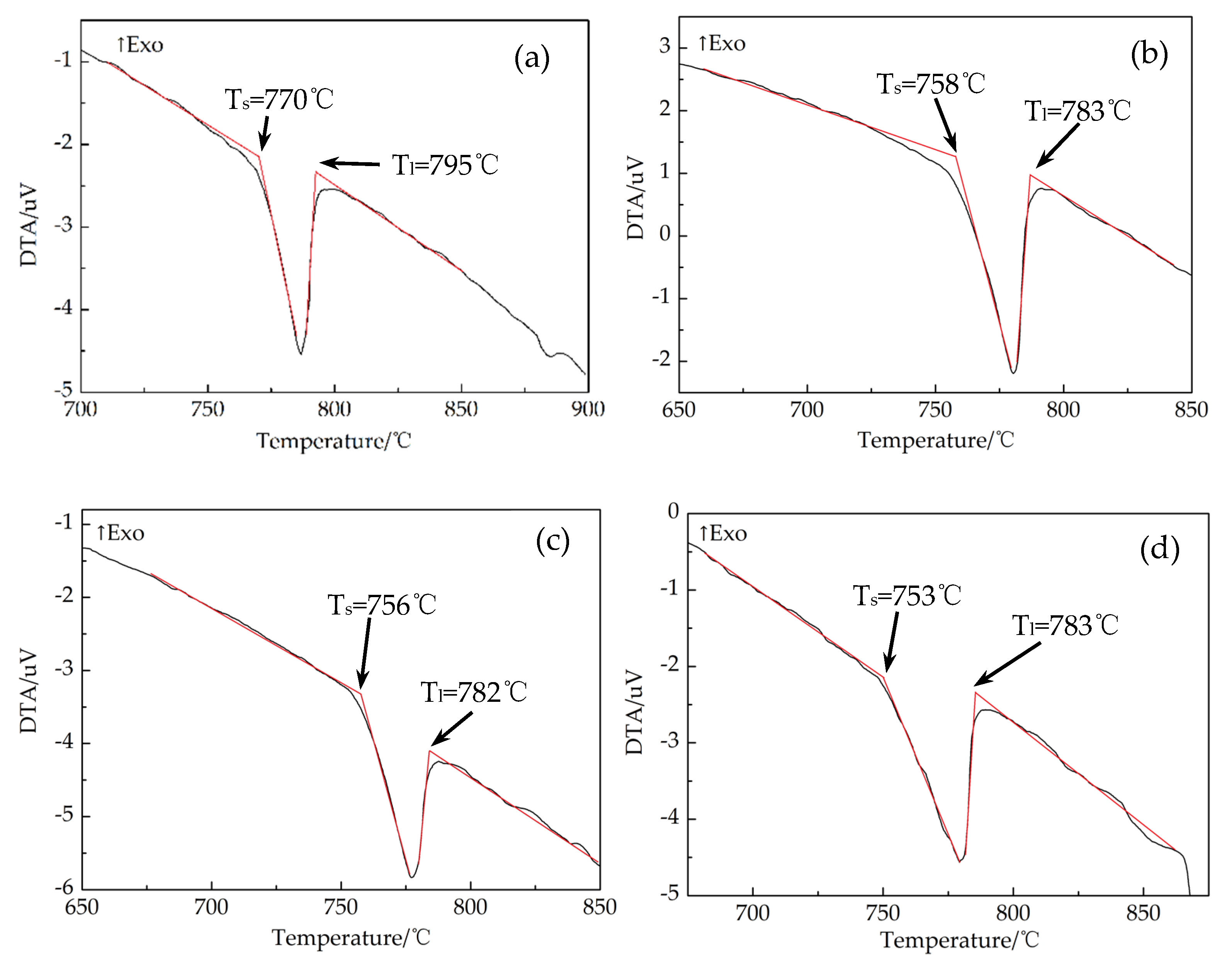
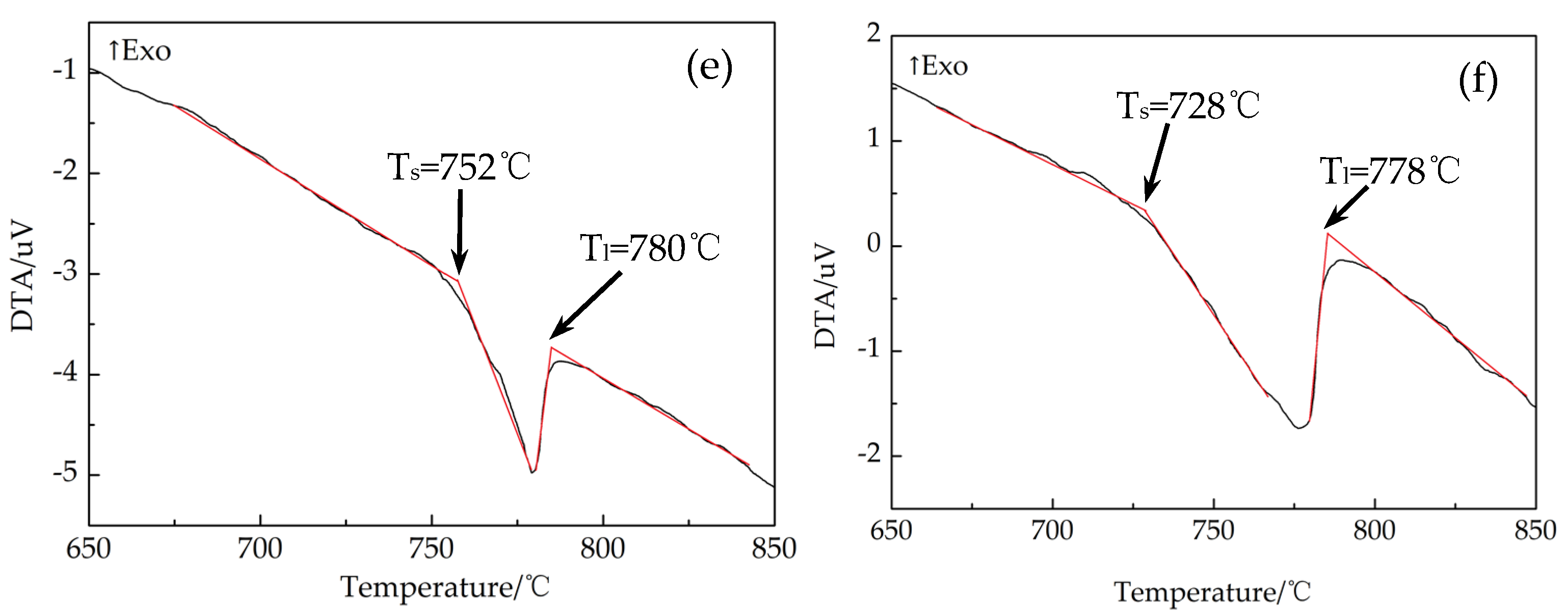

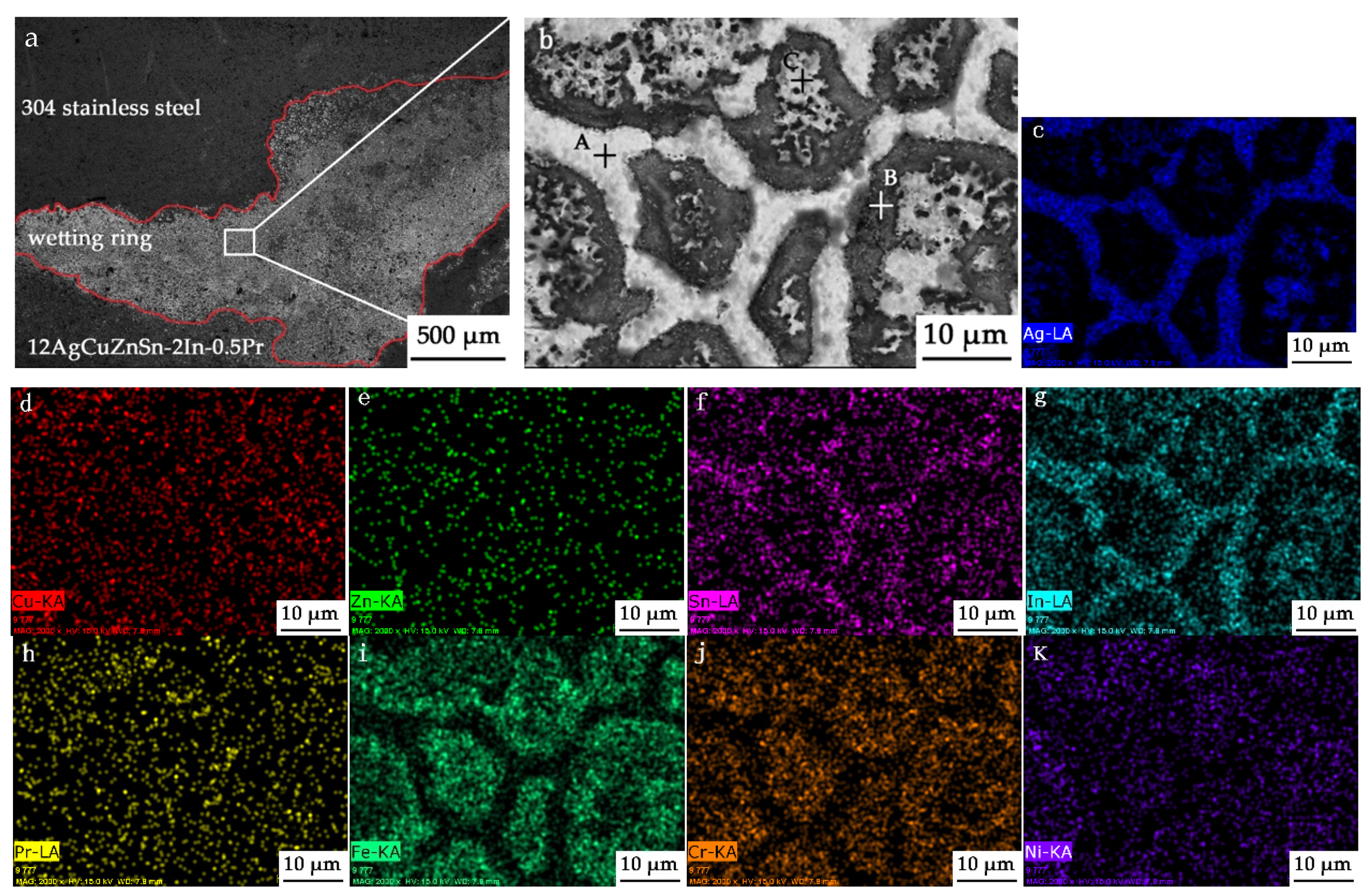

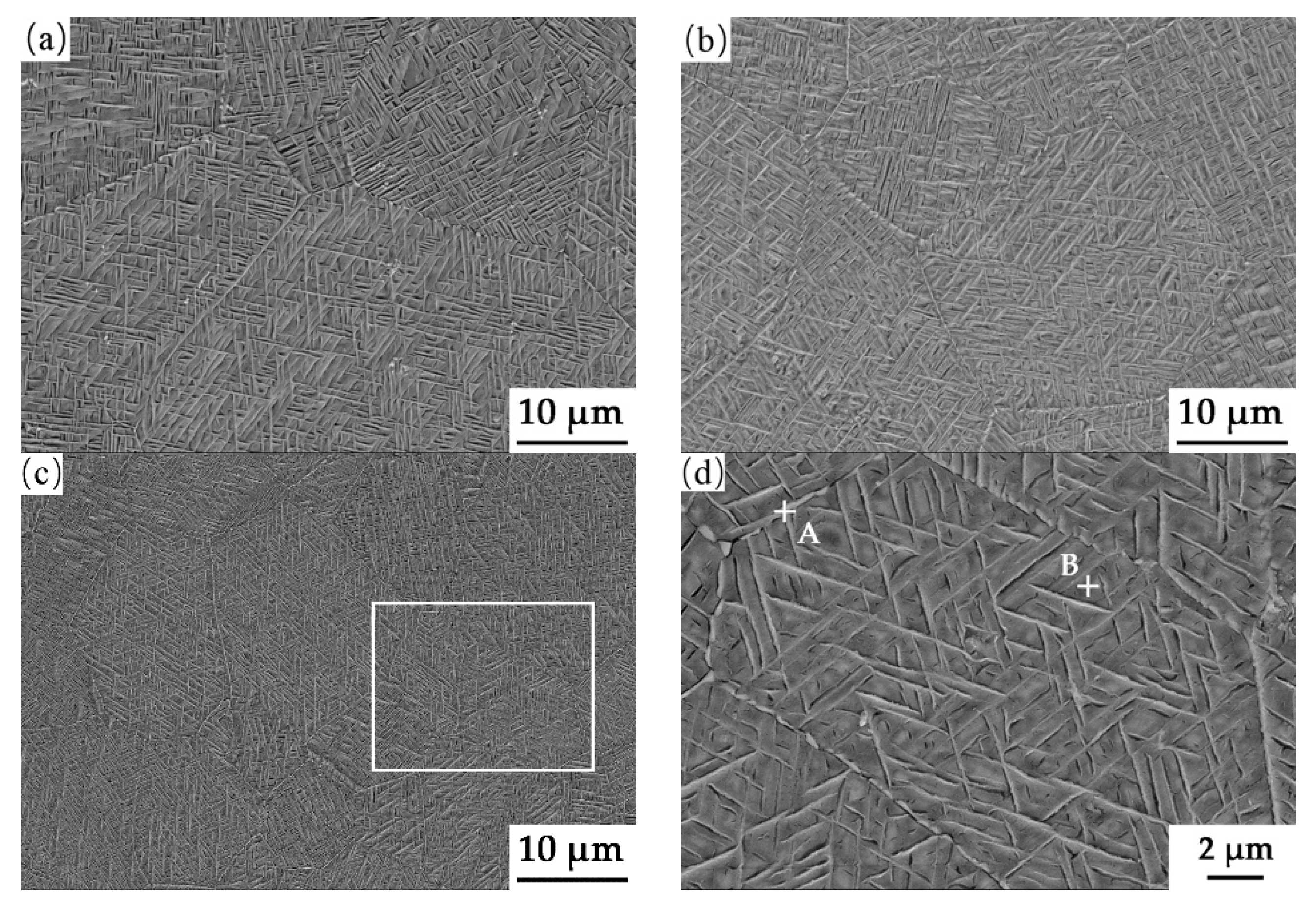

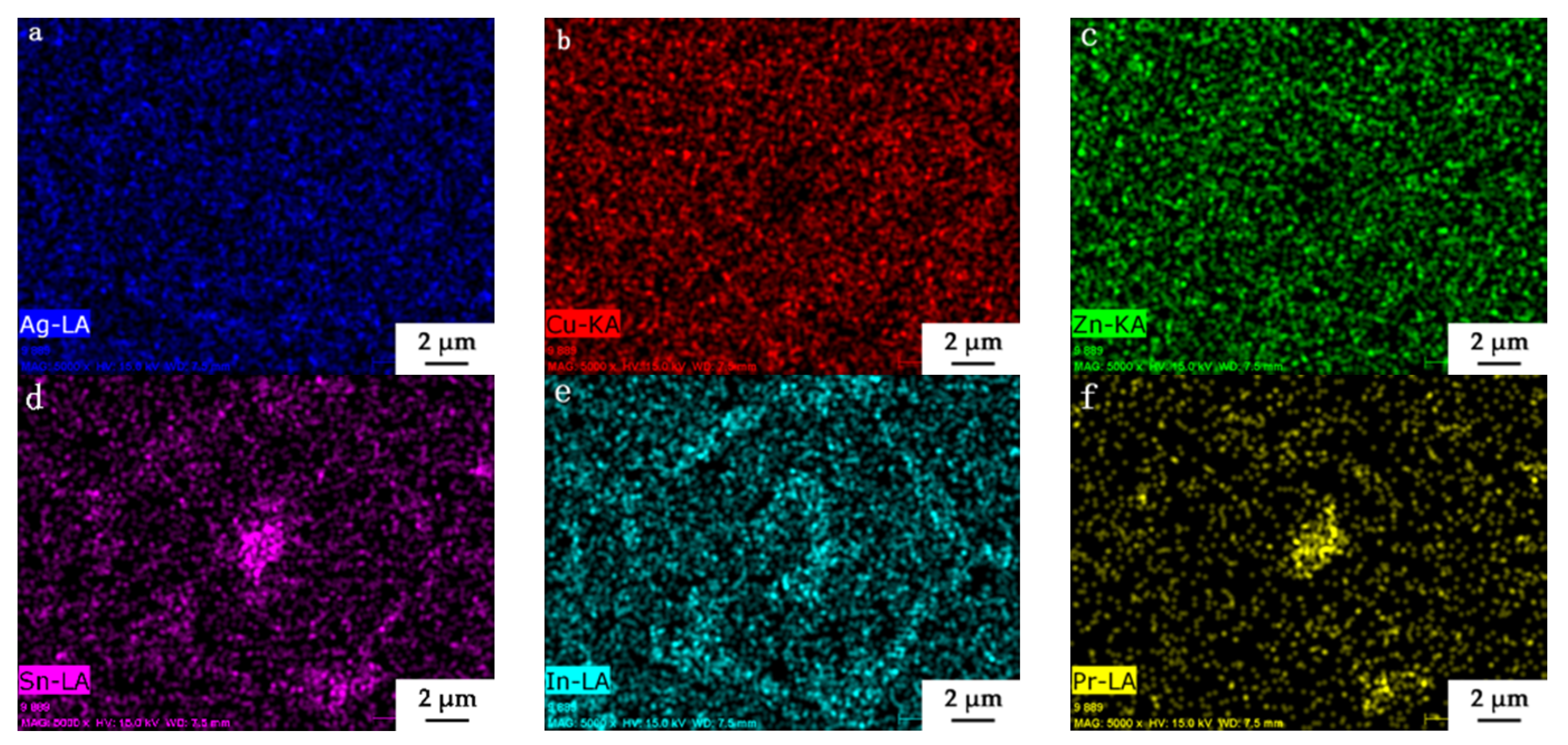

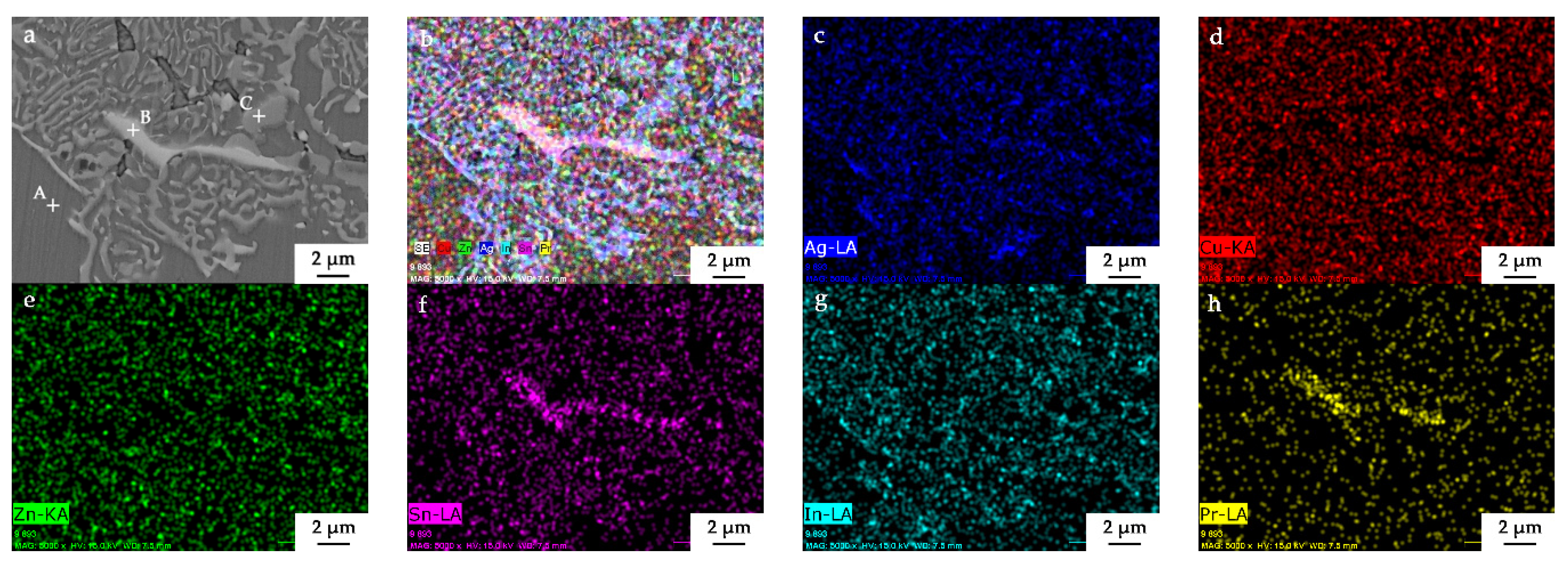
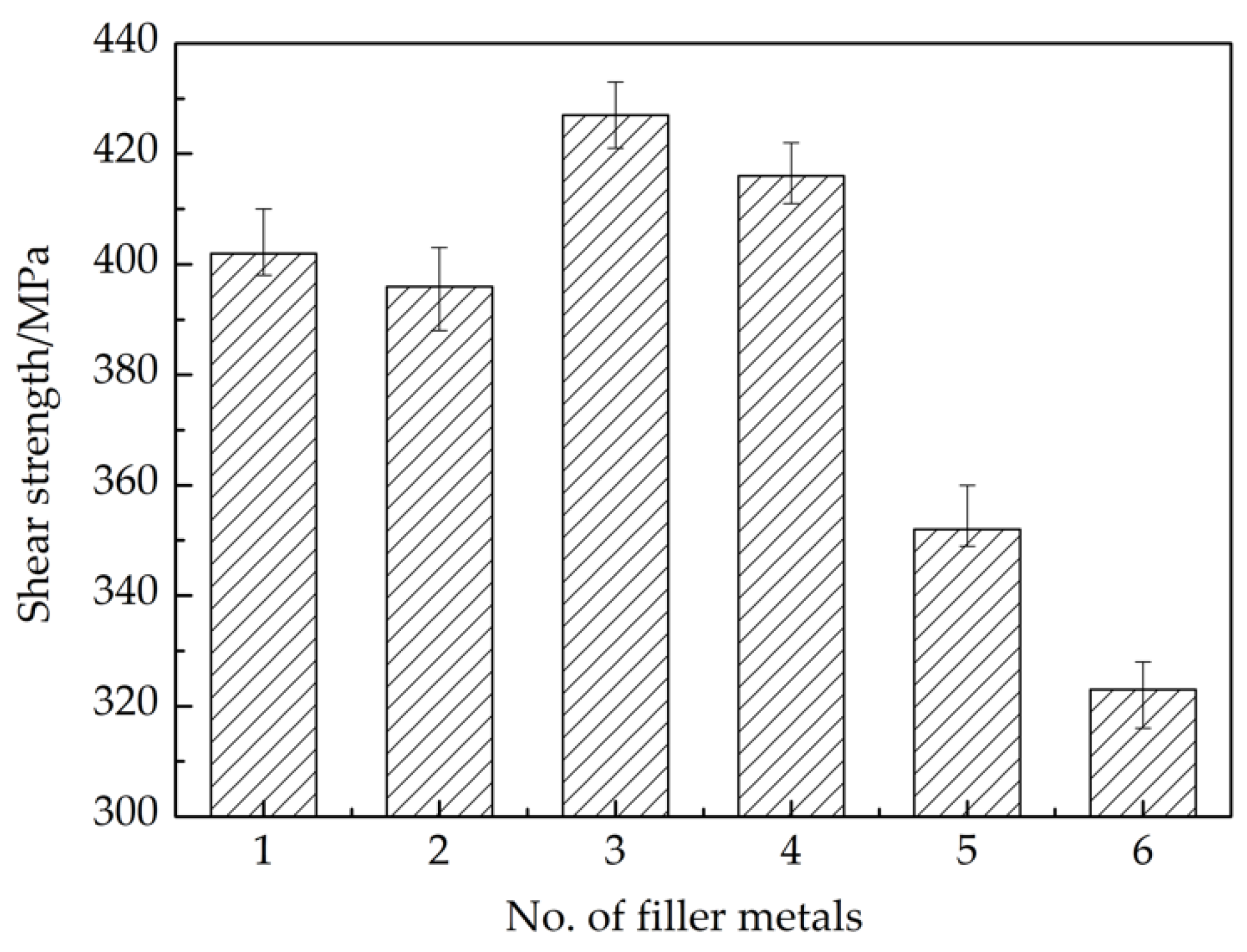


| Filler Metals No. | Ag | Cu | Zn | Sn | In | Pr |
|---|---|---|---|---|---|---|
| 1 | 12.0 | Bal. | 38.3 | 1.5 | 1.0 | 0.1 |
| 2 | 12.0 | Bal. | 37.8 | 1.5 | 2.0 | 0.1 |
| 3 | 12.0 | Bal. | 37.8 | 1.5 | 2.0 | 0.15 |
| 4 | 12.0 | Bal. | 37.7 | 1.5 | 2.0 | 0.3 |
| 5 | 12.0 | Bal. | 37.6 | 1.5 | 2.0 | 0.5 |
| 6 | 12.0 | Bal. | 36.1 | 1.5 | 5.0 | 0.5 |
| Points | Ag | Cu | Zn | Sn | In | Pr | Fe | Cr | Ni |
|---|---|---|---|---|---|---|---|---|---|
| A | 70.64 | 10.34 | 2.55 | 2.72 | 8.82 | 0.68 | 2.12 | 1.44 | 0.69 |
| B | 0.06 | 0.65 | 0.92 | 0.07 | 0.11 | 0.14 | 70.57 | 19.85 | 7.63 |
| C | 59.39 | 6.30 | 1.48 | 1.43 | 5.65 | 1.76 | 18.02 | 4.23 | 1.74 |
| Points | Ag | Cu | Zn | Sn | In | Pr |
|---|---|---|---|---|---|---|
| A | 29.32 | 35.73 | 29.84 | 2.49 | 2.54 | 0.08 |
| B | 4.85 | 59.77 | 34.60 | 0.41 | 0.32 | 0.05 |
| C | 13.01 | 44.99 | 31.83 | 2.13 | 8.02 | 0.02 |
| D | 7.86 | 30.62 | 5.56 | 31.48 | 0.92 | 23.56 |
| Points | Ag | Cu | Zn | Sn | In | Pr |
|---|---|---|---|---|---|---|
| A | 6.73 | 59.56 | 32.57 | 0.62 | 0.47 | 0.05 |
| B | 9.10 | 28.85 | 6.86 | 29.60 | 0.92 | 24.67 |
| C | 40.24 | 29.63 | 20.66 | 2.54 | 6.85 | 0.08 |
Publisher’s Note: MDPI stays neutral with regard to jurisdictional claims in published maps and institutional affiliations. |
© 2021 by the authors. Licensee MDPI, Basel, Switzerland. This article is an open access article distributed under the terms and conditions of the Creative Commons Attribution (CC BY) license (https://creativecommons.org/licenses/by/4.0/).
Share and Cite
Wu, J.; Xue, S.; Zhang, P. Effect of In and Pr on the Microstructure and Properties of Low-Silver Filler Metal. Crystals 2021, 11, 929. https://doi.org/10.3390/cryst11080929
Wu J, Xue S, Zhang P. Effect of In and Pr on the Microstructure and Properties of Low-Silver Filler Metal. Crystals. 2021; 11(8):929. https://doi.org/10.3390/cryst11080929
Chicago/Turabian StyleWu, Jie, Songbai Xue, and Peng Zhang. 2021. "Effect of In and Pr on the Microstructure and Properties of Low-Silver Filler Metal" Crystals 11, no. 8: 929. https://doi.org/10.3390/cryst11080929






